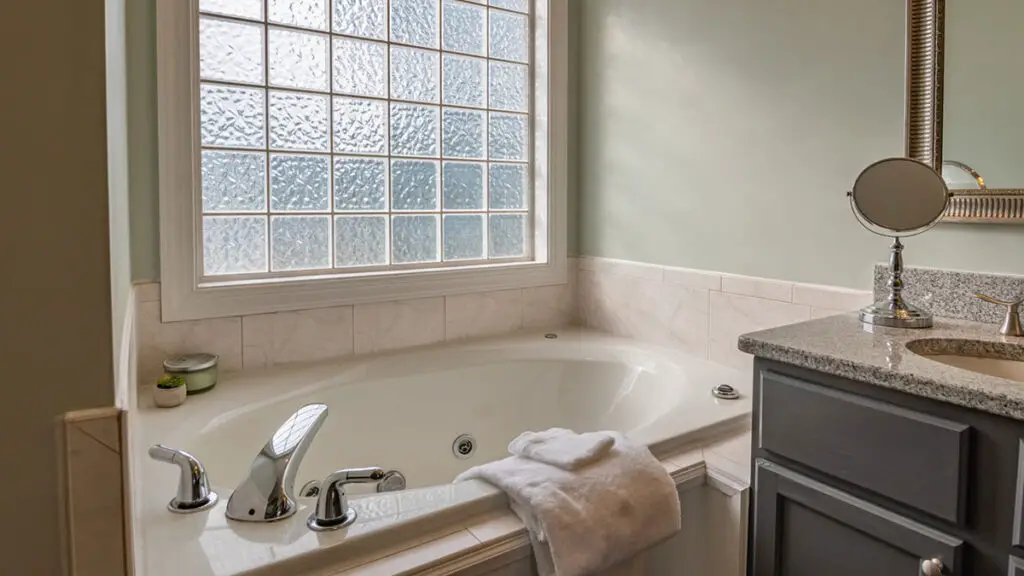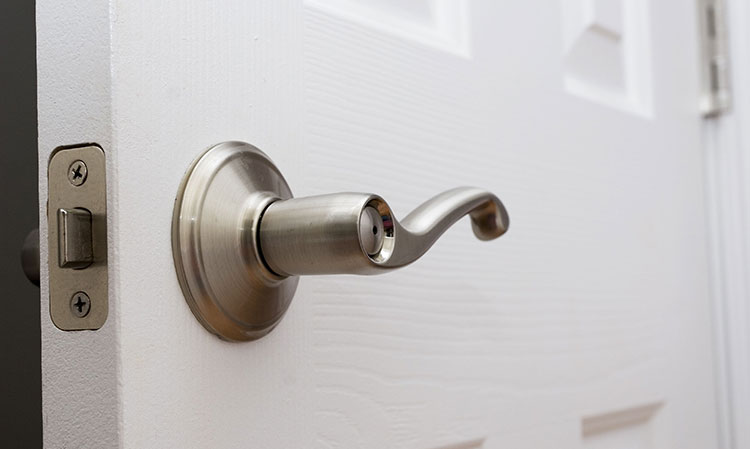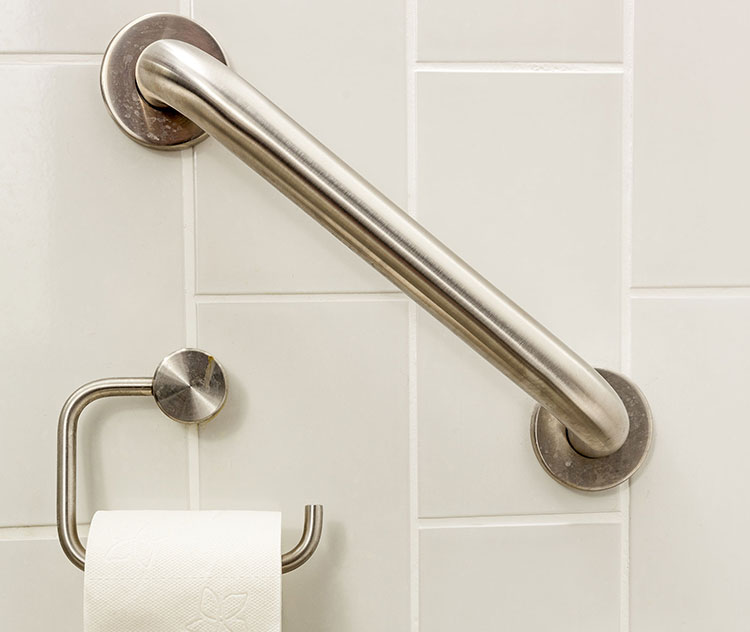Home safety for people with Alzheimer’s is a serious concern. Here we’re going to look specifically at Alzheimer’s Disease bathroom safety. This room is particularly dangerous. The bathroom and the kitchen are probably the two most dangerous rooms in the house for someone with dementia.
Although your loved one will not be hanging out in the bathroom, it’s a room that is used often. Before your loved one uses this space, you need to address potential safety concerns. I’ll cover the steps to make the bathroom safer. Go through the article and then download and print the checklist below to use as you assess the safety of the bathroom(s) in your house.
Alzheimer’s Disease Bathroom Safety Checklist (PDF)
Keep a comforting and homey environment in mind. Although you may need some fixtures or equipment that are used in institutions, try to avoid a hospital-like setting.
Remember, you want your loved one to feel comfortable and at ease.
Step 1: Make the Bathroom Easy to Locate
First, it is necessary to make sure that the bathroom is easy to locate. This will help prevent frustration and possible accidents that have to be cleaned up when the bathroom cannot be found.
Any person that becomes disoriented in the house should have a label on the bathroom door to make locating it easier. Before that, though, there could be a walk to the bathroom, perhaps down a long hallway. Here are some basic tips to make navigating to the bathroom safer:
- The hallway should have enough light. Nightlights ensure the individual can navigate his or her way to the bathroom after dark.
- Installing handrails in the hallway will give your loved one stability. Installing them on one side of the hall may be enough.
- Hang signs on the walls with arrows pointing to the bathroom. This may help the person find the bathroom. The bathroom door should be kept open at night while doors to other rooms should be closed to discourage wandering into them.
- Look at the colors in the bathroom. Is everything white? Having the same color throughout the bathroom will make things hard to find for the person with dementia. A floor with some color contrasting to the toilet and bathtub will be a great help in finding the toilet, especially at night. If you have a linoleum floor, it will be easier and less costly to change.
Step 2: Make it Easy to Enter and Exit the Bathroom
Once your loved one gets to the bathroom, can they effectively enter and exit on their own? The bathroom door itself could be a barrier. Older people have trouble gripping, so knobs become a problem. Door levers are much easier to turn than knobs.
- IDEAL USE: Passage function is perfect for use on interior hall and closet doors where locking is not needed or paired with a deadbolt on exterior doors; door handle is non-locking for ease of entry
- EASY INSTALLATION: Self-aligning screw holes make installation hassle-free; everything included to upgrade existing single bore hole doors yourself in minutes with only a screwdriver; fits both right and left handed doors
If the door continues to be in the way, it may be necessary to remove it completely. If so, hang a curtain in the doorway that is easy to move aside. It may be something to get used to, even for the person with dementia, but this adjustment may be necessary to facilitate ease in entering and exiting the bathroom.
Step 3: Provide Enough Lighting
Just as lighting is important in the bedroom, a well-lit bathroom is equally important. Make sure there is plenty of lighting to help older eyes.
- An easy-to-find light switch is a must. Again, you can find glow-in-the-dark switch plates that will help.
- Always have a nightlight or two, depending on the size of the room. Having nightlights may be enough to keep the person from trying to find the light switch for the overhead light. Sometimes it may make sense to leave the bathroom light on all the time, making the bathroom easy to find.
- Dim showers can even be lit up with specialty built-in lights. This type of alteration will require an electrician.
- 【MOTION/LIGHT SENSOR】— Last longer lifetime and keep more energy saving. The motion detector distance is within 18 feet . Turn ON motion sensor function by RF remote when use motion detector. Please Press the key "M/ON" for ON, and "M/OFF" for OFF. The red indicator light will flash when the motion sensor is working.
- 【REMOTE CONTROL FUNCTION】 — Remote can let you control the ceiling light through walls, doors or more barrier. Also ,the timer button on the remote can turn OFF the light automatically after 15/30/60/120 mins. If you want to adjust the brightness, just press the symbol + or - on the remote.
Step 4: Make the Flooring Safe
Many tile floors are very slippery once they get wet. To see if this is the case, wet your floors and test them. If they are slippery, apply a non-skid material that will help. However, you may decide to go with another type of flooring completely.
- An alternative to bathroom tile or linoleum is removable, washable carpet. Having carpet lessens the possibility of slipping on wet tile while providing the room with a warmer look and feel. If you do opt for carpet, look for carpet with a surface that is easy to clean.
- Apply Scotchgard to a bathroom carpet. This will help protect carpet from accidents and make cleaning easier. Some long-term care facilities use carpet that comes in squares for easy replacement should a section of the carpet become damaged.
- Strong fabric protection repels spills for easier cleanup
- Ideal for household items like upholstery, curtains, pillows, table linens, backpacks, luggage and more
Whatever you decide on the flooring, make sure the surface is smooth throughout the bathroom. Check the threshold into the bathroom to make sure it isn’t a different height from the flooring.
Finally, remove throw rugs if falling is a hazard. While throw rugs are a practical and warm bathroom accessory, they contribute to tripping and falling, which could result in injury on a hard bathroom floor.
Step 5: Make Any Changes to the Toilet, Tub, and Shower
Finding the toilet is one of the most important considerations in the bathroom. Spend some time looking at your options, as a stress-free toileting experience will make a significant difference in the wellbeing of the person with Alzheimer’s.
- If the toilet is too low and hard for the individual to get up from, adjust the height with a toilet riser. Some toilet heights are better than others. Toilet risers are a workaround. A bedside commode also works well for raising the toilet and providing something to hold onto. Grab bars can be installed in key places to aid with sitting down and getting back up.
- ADDED 5" in HEIGHT: The Toilet Safety Seat raises the toilet commode by 5 inches. The elevated toilet seat with foam padded arms makes it safer and easier to sit or stand while using the toilet.
- ADJUSTABLE WIDTH ARMS: The two handles are adjustable in width to conform both narrow and wide body types. The width can be expanded from 18.5" to 21.5". The arms are removable and padded with a soft foam that provides soft grip but nonslip for safety and stability.
- Purchasing a colorful toilet seat or cover for the toilet lid will help distinguish the toilet from its surroundings. This makes it much easier for the person to find.
- Make the toilet comfortable. You can replace a hard seat with a soft one. A cold, hard seat in the middle of the night might deter the person from using the bathroom, which could lead to an accident. You can also purchase “comfort height” toilets that sit higher and are easier to get on and off.
- Consider a bidet. The bidet is common in many countries, and a bidet attachment can be easily installed to your existing toilet. They provide a spray of water to the bottom area allowing for faster and easier clean up.
- Install a grab bars. This makes getting off and on the toilet easier and safer. These can be positioned next to the toilet. Shower standing handles are available for the shower itself.
- If there are glass doors, remove them and replace them with a shower curtain. Again, grab bars are your friend. Install them in and around the shower and tub.
- Have a shower seat available and install a shower hose. Shower seats and transfer benches allow individuals to shower while sitting down. This will also be highly beneficial when they require assistance bathing. A handheld shower head will make cleaning “hard to reach” areas much easier when helping the confused or uncooperative person.
- Make sure the floor of the shower or tub is covered with non-slip decals or a non-skid mat. These are inexpensive and easy to install.
- A brightly colored floor mat in the tub can help the older person with depth perception. Adding a foam rubber faucet cover in the tub will also help prevent injury if the person hits the faucet in the event of a fall. These foam rubber covers are often found in the children’s section of department stores, as they are a general child-safety product for the home.
- A walk-in tub with a door that opens into the bathtub can be a big help. While these tubs are costly, they could be the answer to a safer bathing experience for the person who has trouble with balance lifting legs up.
Step 6: Address Other Necessary Changes
Each living environment differs, so here is a list of other possible changes that should be made.
- Remove the trash can to prevent toileting in it. It is unfortunate, but it happens. If this bathroom is shared with other family members, put the trash can in the cabinet under the sink for others to use. Make sure you put a child safety lock on the cabinet to prevent rummaging through the trash.
- Install an anti-scalding device to prevent burns from hot water. You can adjust your hot water heater to a pre-set temperature, around 105 degrees or so, but the lower water temperature could cause issues with other household needs. To make using the water from the sink easier, you could install a faucet that goes on and off automatically, similar to the ones you see in public restrooms. If you don’t go with the automatic faucet, make sure the knobs are easy to turn and are within reach.
- Sharp corners on bathroom cabinets and counters should be padded. Foam pipe insulation is an easy, affordable option. Just secure it around the edges. These are available at any home improvement store. A recessed counter, while a more major alteration, will ensure that the sink is reachable. Be sure to have an accessible hand towel near the sink, too.

- Replace towel bars in locations where they might be grabbed to prevent a fall. Flimsy towel racks won’t prevent falls and could be pulled right out of the wall. Replace them with grab bars.
- Add a small drain screen to the sink. This will save anything—such as valuable rings—from going down the drain.
- If your loved one can still shave, provide him with an electric shaver away from the sink. An old-fashioned razor is out of the question, but an electric shaver allows a level of independence that a man will appreciate. Make sure it is rechargeable and doesn’t require an electrical cord next to the sink.
- Cover or remove mirrors. This is important if the individual’s image confuses or frightens him or her. As dementia progresses, people think of themselves as younger than they are. They may not recognize themselves in the mirror. It is not uncommon to have a person leave a bathroom and say, “There’s a stranger in there.” Cover windows with blinds or curtains. Remove any breakable items from the counters. Remove any wall hooks, such as those for robes or towels that the person could fall into.
- Place locks on medicine cabinets or remove unsafe items completely. Everyday items you are accustomed to having in the bathroom now present a threat. This could include: mouthwash, nail polish, medications of any kind, perfumes, cleaning supplies, etc. Locks should go on any cabinets that contain chemicals, even personal items such as shampoo. One place a lock should not go, however, is on the door inside the bathroom. Don’t risk your loved one getting locked in. If the bathroom has a window, add a safety lock there for additional security.
- Install shelves for items that your loved one needs to access. Shelves should be easily reached and sturdy (they may act as grab bars if your loved one were to slip). Such shelves could hold clean towels, facial tissues, and extra rolls of toilet paper. All family members should be instructed to keep any other items off those shelves to reduce confusion and a sense of feeling overwhelmed.
- Remove glass items. Ceramic items, glass shelving, drinking glasses—don’t risk harm by having any of these in the bathroom. Replace glass shelves with wood, and glass cups with plastic.
- Make the bathroom warm. Never leave a person with dementia alone with a space heater; however, older people often feel colder than the average person, especially in the bathroom. Since many with dementia have aversions to bathing, the more you can do to make the bathroom comfortable, the better. Before the person takes a bath or shower, make sure the bathroom is warm—warmer than you would want it. If that involves bringing in a space heater, go ahead: just remove it before proceeding with the bath. Instead of a space heater, you could install heating lamps in the ceiling. This option, a job which may require an electrician, is much safer. If exhaust fans are already installed, make sure to keep them turned off when the person is in the bathroom. Excess noise can cause confusion, so keep the bathroom as calm and quiet as possible.
- As the level of care provided for the person with Alzheimer’s increases, a mechanical chair lift is an option that may be needed down the road. Getting on and off the toilet will get harder, as will be getting in and out of the shower or tub. Lifts will aid in safety transferring the individual from a wheelchair to the toilet and back, as well as to the bathtub and back. While mechanical lifts are expensive and take up some room, they are a lifesaver and a back saver.
With more equipment in place, the bathroom has the tendency to become more institutional-looking. Paint and carpet, or other flooring options, should be warm colors which will help ward off this look. Maintain the homey look and feel as much as possible with personal touches like familiar pictures on the wall and pretty curtains on the windows. Even colorful, fluffy towels will help maintain the feel of home.
As care needs increase, you will need to take more measures to ensure that needs are met. These interventions will be easier to implement since you will already have a number of safety measures in place. In the beginning, start with the adjustments you can make to ensure the bathroom is as safe as it can possibly be without sacrificing a home-like environment. When you need to add more, you will know in advance what that will be—and you will be prepared.
After Addressing Alzheimer’s Disease Bathroom Safety
This is the third article in this series. Further articles will cover other rooms:
- General Home Safety
- Bedroom Safety
- Living Room Safety
- Kitchen Safety
- Hallways and Entryways
- Outside the Home
Check each of these articles as they become published to continue your home safety assessment.
Want to read my complete guide? See my book Staying Home.
- Grant, Derrick (Author)
- English (Publication Language)









